Extensive rewiring of epithelial-stromal co-expression networks in breast cancer

View/
Author
Christensen, Stephen M
Jeong, Jong Cheol
Glass, Benjamin
Montaser-Kouhsari, Laleh
Knoblauch, Nicholas W
Bertos, Nicholas
Saleh, Sadiq MI
Haibe-Kains, Benjamin
Park, Morag
Note: Order does not necessarily reflect citation order of authors.
Published Version
https://doi.org/10.1186/s13059-015-0675-4Metadata
Show full item recordCitation
Oh, E., S. M. Christensen, S. Ghanta, J. C. Jeong, O. Bucur, B. Glass, L. Montaser-Kouhsari, et al. 2015. “Extensive rewiring of epithelial-stromal co-expression networks in breast cancer.” Genome Biology 16 (1): 128. doi:10.1186/s13059-015-0675-4. http://dx.doi.org/10.1186/s13059-015-0675-4.Abstract
Background: Epithelial-stromal crosstalk plays a critical role in invasive breast cancer pathogenesis; however, little is known on a systems level about how epithelial-stromal interactions evolve during carcinogenesis. Results: We develop a framework for building genome-wide epithelial-stromal co-expression networks composed of pairwise co-expression relationships between mRNA levels of genes expressed in the epithelium and stroma across a population of patients. We apply this method to laser capture micro-dissection expression profiling datasets in the setting of breast carcinogenesis. Our analysis shows that epithelial-stromal co-expression networks undergo extensive rewiring during carcinogenesis, with the emergence of distinct network hubs in normal breast, and estrogen receptor-positive and estrogen receptor-negative invasive breast cancer, and the emergence of distinct patterns of functional network enrichment. In contrast to normal breast, the strongest epithelial-stromal co-expression relationships in invasive breast cancer mostly represent self-loops, in which the same gene is co-expressed in epithelial and stromal regions. We validate this observation using an independent laser capture micro-dissection dataset and confirm that self-loop interactions are significantly increased in cancer by performing computational image analysis of epithelial and stromal protein expression using images from the Human Protein Atlas. Conclusions: Epithelial-stromal co-expression network analysis represents a new approach for systems-level analyses of spatially localized transcriptomic data. The analysis provides new biological insights into the rewiring of epithelial-stromal co-expression networks and the emergence of epithelial-stromal co-expression self-loops in breast cancer. The approach may facilitate the development of new diagnostics and therapeutics targeting epithelial-stromal interactions in cancer. Electronic supplementary material The online version of this article (doi:10.1186/s13059-015-0675-4) contains supplementary material, which is available to authorized users.Other Sources
http://www.ncbi.nlm.nih.gov/pmc/articles/PMC4471934/pdf/Terms of Use
This article is made available under the terms and conditions applicable to Other Posted Material, as set forth at http://nrs.harvard.edu/urn-3:HUL.InstRepos:dash.current.terms-of-use#LAACitable link to this page
http://nrs.harvard.edu/urn-3:HUL.InstRepos:17295769
Collections
- HMS Scholarly Articles [17920]
Contact administrator regarding this item (to report mistakes or request changes)


